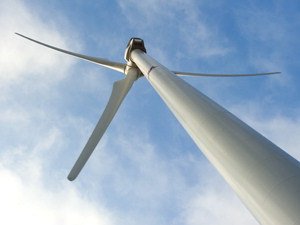U.S. Deputy Secretary of Energy Poneman and Sen. Franken to tour U of M Wind Energy Research Station

Contacts: Julie Bodurtha, St. Anthony Falls Laboratory, jgb@umn.edu, (612) 626-6166
Rhonda Zurn, College of Science and Engineering, rzurn@umn.edu, (612) 626-7959
Kristin Anderson, University News Service, kma@umn.edu, (612) 624-1690
MINNEAPOLIS / ST. PAUL (01/26/2012) — U.S. Deputy Secretary of Energy Daniel Poneman and U.S. Sen. Al Franken will tour the University of Minnesota wind energy research station at UMore Park at 11 a.m. Friday, Jan. 27. Fotis Sotiropoulos, director for the St. Anthony Falls Laboratory and civil engineering professor, will host the tour showcasing cutting-edge academic research and industry partnerships related to wind energy.
Earlier this week in his State of the Union address, President Obama highlighted the importance of investing in clean energy technology to create jobs and secure America’s economic future.
The Wind Energy Research Station includes a 415-foot, 2.5 megawatt wind turbine and a 426-foot meteorological research tower. The facility is equipped with state-of-the-art instruments and sensors to simultaneously measure the approach wind fields and the impact they have on the turbine structural reliability and wind energy capturing ability.
Poneman, Franken and Sotiropoulos will hold a brief press availability immediately following the tour.
About the Wind Energy Research Consortium
The University of Minnesota was one of only three university consortia to be awarded a U.S. Department of Energy (DOE) wind energy research grant in 2009. The $7.9 million award to the University’s St. Anthony Falls Laboratory in the College of Science and Engineering, funded through the American Recovery and Reinvestment Act (ARRA), supports an academy-industry consortium focused on wind energy research and education activities. It also includes construction of the U.S.-made 2.5 megawatt Clipper Liberty wind turbine. The Wind Energy Research Station will host not only active consortium research, but also education and training of next generation wind industry workers.
The consortium has stimulated new educational initiatives and helped establish collaborative research projects that are helping accelerate the development of new wind power technologies. Ongoing research projects deal with capturing more energy from the wind, improving wind farm design, minimizing turbine impact on radar, reducing turbine noise, preventing ice build-up on blades, monitoring turbine performance, and improving turbine blade structure.
Consortium partners are the University of Minnesota-Twin Cities, the Center for Compact and Efficient Fluid Power, Syracuse University, Dakota County Technical College, Mesabi Range Community and Technical College, 3M, Barr Engineering, Clipper Windpower LLC., United Technologies Research Center, Lockheed Martin, Micron Optics, Ryan Companies, WindLogics, Xcel Energy, Sandia National Laboratories, and the National Renewable Energy Laboratory. The University of Minnesota’s Initiative for Renewable Energy and the Environment (IREE) and UMore Park provided early-stage research funding to support consortium collaborations.
For more information about the Wind Energy Research Consortium, visit www.eolos.umn.edu.
